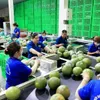Cashew industry proactive in raw materials, increasing deep processing
The direction of cashew development has been shown in Decision No.431/QD-BNN-TT, dated January 26, 2024, of the Ministry of Agriculture and Rural Development on approval of the Project on developing key industrial crops to 2030.
Specifically, by 2030, the nationwide cashew area will be about 280,000-300,000 hectares. The key cashew growing area in the Southeast is about 170,000-180,000 hectares and the Central Highlands is about 80,000-90,000 hectares. The remaining 10,000-30,000 hectares are grown in the provinces of Binh Thuan, Ninh Thuan, Khanh Hoa, and Binh Dinh.
Selecting good varieties, stabilising the growing area
According to Deputy Director of the Department of Crop Production under the Ministry of Agriculture and Rural Development Nguyen Quoc Manh, the Ministry of Agriculture and Rural Development does not have a policy to expand the cashew growing area. Therefore, to stabilise the growing area, several solutions have been proposed, such as reorganising production; implementing replanting, renovating and restoring old cashew gardens, infected with pests and diseases, and unqualified varieties; applying science and technology and transferring varieties and technical advances into production.
The reorganisation of production will be based on building models in two directions: horizontal and vertical linkage. Horizontal linkage is the linkage between cashew-growing households to form production organisations, such as cooperatives, cooperative economic groups, production solidarity groups, high-yield cashew-growing clubs, cashew-growing farmers' alliances, etc., to create consensus among local cashew-growing households, creating conditions for receiving technical advances, market information, prices and receiving State policies.
Vertical linkage links cashew production organisations and cashew processing and export enterprises. The State encourages and through farmers' production organisations implements policies for cashew growers, such as supporting seed and fertiliser, transferring technical advances, implementing preferential policies, and borrowing capital.
Cashew growers in the planning area are approved by competent authorities for land use rights and assets on land to contribute shares, joint ventures, and production links with export processing enterprises to do business together and benefit or transfer to form agricultural enterprises.
For replanting, replant or graft old cashew areas over 30 years old, low yield with higher yield varieties, suitable for processing such as PN1, AB29, AB05-08, and LBC5.
The goal by 2030 is that about 80-90% of newly planted cashew areas will use standard varieties; the area of cashew trees applying intensive technical processes will account for 40-50%. During the implementation process, each locality will develop a plan and specific steps to renovate and restore cashew gardens, aiming to improve quality, increase productivity, efficiency and increase income for people.
Identifying varieties as an important factor in production, the Ministry of Agriculture and Rural Development has oriented research to select and create good cashew varieties, adaptable to each ecological region: Southeast, Central Highlands and South Central Coast.
Research on cashew trees has had some initial results, the selection and import of varieties have been focused on; many technical advances have been researched and applied to production, contributing to improving cashew productivity and output, Manh said, adding that some localities with large cashew areas have selected superior parent trees with high productivity, good quality, pest resistance, and local adaptability; organised evaluation and propagation for replanting, renovating and restoring old cashew gardens; and built parent gardens and original breeding gardens.
Diversifying forms of production and processing linkage
In the cashew "capital" of Binh Phuoc, to solve the problem of raw materials, many businesses have linked up with agricultural cooperatives to grow cashews and consume products. The Golden Cashew One Member Co., Ltd. (Bu Nho Commune, Phu Rieng District) has linked up with the Hoa Phu Clean Agricultural Cooperative (also in Bu Nho Commune) to build a raw material area to ensure supply for the company’s production.
Director of the Golden Cashew Company Vu Manh Tung said, that linking production with farmers has created a stable source of quality input materials for the company and brought stable income to members. Thanks to that, in a short time, the company has a cashew raw material area of over 300 hectares. This has contributed to forming a chain of production and consumption of products according to the value chain and the application of high-tech agriculture, production according to quality standards and good agricultural practices, with little impact on market prices.
Meanwhile, Ha My Joint Stock Company (Dong Phu District) has focused on building a cashew nut raw material area by supporting farmers with seedlings, the company has built a process for planting and caring for organic cashew trees and distributed diary books to farmers to trace the origin of cashew nuts. Thanks to that, the company now has hundreds of hectares of raw cashew nuts.
To increase the value of the cashew industry, aiming for sustainable development, in addition to linking to create a stable raw material area, businesses need to promote investment in clean production and deep processing.
The Ministry of Agriculture and Rural Development said that in the coming time, there will be a rearrangement of cashew processing facilities in the direction of reducing the number of main points, reducing small processing facilities that do not ensure food hygiene and safety conditions; forming large processing facilities with modern equipment and technology; encourage and create conditions for cashew processing enterprises to associate and form joint ventures to form companies with financial potential, high technology level, and strong brands to participate in domestic and foreign markets.
According to Chairman of Binh Phuoc Provincial People's Committee Tran Tue Hien, currently, enterprises are investing in modern machinery for specialised processing according to the motto "cashew nuts in Binh Phuoc are purchased and processed to bring to consumers’ meals".
Ba Tu cashew nuts are a typical brand of Binh Phuoc Province built by Gia Bao Group Joint Stock Company (Dong Xoai City). The company has just started constructing the Ba Tu Binh Phuoc Agricultural and Food Processing Factory with an investment of 6.5 million USD, on an area of 20,000 square metres with a capacity of 4,000 tonnes per year.
Activities will be implemented with maximum clean energy sources, from production to lighting, all using solar power. Green production certainly has higher product costs, so the company invests more in products to differentiate, thereby building a certain position in the market. In particular, green production will contribute to reducing emissions, creating a competitive advantage for the company’s products, especially when developed countries are prioritising the import of these items.
Tags:





